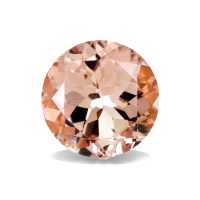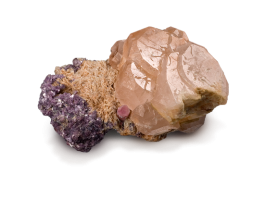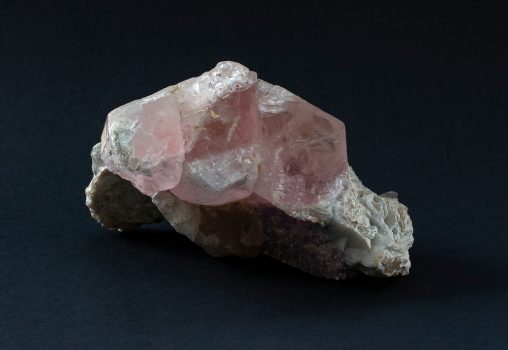Morganite


Morganite is the pink to orange-pink variety of beryl, a mineral that includes emerald and aquamarine.

Morganite Description
Like many gems found in pegmatites, morganite can form large crystals. Miners in Brazil have found crystals as large as 22 lbs. (10 kg). The Smithsonian Institution in Washington, D.C., includes two faceted gems weighing 236 cts. and 250 cts. in its collection. Although morganite is rarer than aquamarine, large cut stones are readily available on today’s market. That’s probably because morganite hasn’t been promoted to the jewelry-buying public nearly as widely as aquamarine or emerald.
Most of the morganite on the market comes from pegmatite mines in Minas Gerais, Brazil. Afghanistan, Mozambique, Namibia, and the US have been minor and inconsistent sources. While it’s only a minor producer today, the original Madagascar deposit still sets the standard for the best material. That location’s yield of magenta-colored rough was superior to crystals from other sources.
Gemstone Details
Morganite Gemstone as rough

Morganite History and Lore
Following the discovery of a new locality for rose beryl in Madagascar in 1910, George Kunz proposed the name morganite at a meeting of the New York Academy of Sciences on 5 December 1910 to honor his friend and customer J.P. Morgan for his financial support for the arts and sciences, and his important gifts of gems to the American Museum of Natural History in New York and to the Museum of Natural History in Paris. Morgan was one of the most important gem collectors in the early 1900s – his collection was partly assembled by Tiffany and Company and their chief gemologist, Kunz.

One of the interesting properties of morganite noted by Kunz was its intense red-colored fluorescence when exposed to X-rays, but no phosphorescence when the X-ray source was turned off.
On October 7th, 1989, one of the largest specimens of Morganite was uncovered. It was found in the Bennet Quarry of Buckfield, Maine, and it was somewhat orangish in hue and about 23 cm long and 30 cm across. This well-formed crystal weighed in at just more than 50 pounds, and was called ‘The Rose of Maine’.
MULTIPHASE INCLUSIONS
Morganite can contain liquid inclusions that contain gas bubbles and possibly also solid phases.
FLATTER PRISMS
Morganite forms beautiful hexagonal prism crystals that tend to be flatter than aquamarine crystals.
PASTEL
Morganite often comes in lighter pastel shades of pink.
COLOUR
Although commonly light in tone, top-quality material is a strong pink.
CLARITY
Faceted morganite, in light and stronger colors, usually has no eye-visible inclusions.
CUT
Light-colored crystals might be cut a little deep to intensify the color.
CARAT WEIGHT
Morganite comes in a variety of sizes, including large faceted gems and designer cuts.